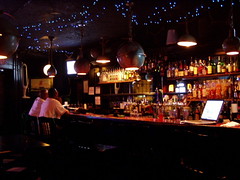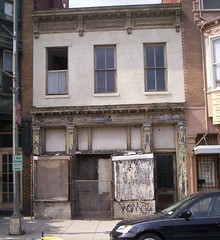Arts vs. arts-plus for commercial district revitalization
Christopher sends us a link to this very interesting article from the Oakland Tribune, "City tries to keep art in W. Berkeley City trying to keep arists, artisans in West Berkeley," about the City of Berkeley's initiative to retain working artists. It appears to be a rigorous process, where they've actually "censused" the West Berkeley area to identify working artists.
From the article:
A new report shows there are more than 800 artists renting work space in West Berkeley and that the area is a hotbed of unique and emerging art forms — from dance to pottery to embodied arts. The preliminary report from a consultant hired by the Civic Arts Commission and funded with $10,000 from the City Council was done to generate new ways to retain artists who rent space in industrial West Berkeley.
"We are trying to come up with new ways and new policies to keep the most vulnerable artists (those who rent) within the city and not have them leave," said Civic Arts Coordinator Mary Ann Merker. "Cities are beginning to realize that the arts are a vital part of their economy and by nurturing them they nurture their city and their fiscal economy."
The city also wants to retain artists who own space in West Berkeley and will be looking for ways to do that down the line. West Berkeley has become a mecca for painters and potters, jewelry makers, glass blowers, dancers, filmmakers, spiritual leaders and other creative types.
"It's the only place left where there is room to grow because of the availability of large warehouse spaces that we don't have in any other part of the city," Merker said.
I am unaware of a similar study in Washington, DC proper. Instead, you could argue that the City of Washington has a specific plan to displace artists judging by:
(1) demolition of artist spaces in favor of the baseball stadium, which led to the relocation of the Washington Glass School to Maryland, and the dissolution of the Washington Sculpture Center;
(2) a failure to retain and improve city-owned buildings that could be used to foster arts uses (i.e., Old Engine Company 10 on Maryland Avenue NE, old Precinct Nine on 9th Street NE, deaccessioned school buildings, etc.);
(3) active encouragement of redevelopment of warehouse areas, despite the industrial lands planning study (Industrial Land Use Study), e.g., the support of a plan to redevelop Florida Market ends up likely to change the General Typographers building, which as the typesetting industry has changed, has mostly been turned over into a building for artists studios... etc.
I think it's fair to say that DC's arts policy focuses on strengthening institutions (see "D.C. wants to redevelop Lincoln Theater's parking lot" from the Washington Business Journal) but not so much individual artists and the support infrastructure and space needs they have.
I know this is an overarching statement. There are many exceptions. Even so, I think there isn't an institutional, coherent response to this need. But then even though the city supports the arts institutions with money, I don't the response is coherent, or at the very least, prioritized, either.
See "Cultural resources planning in DC: In the land of the blind, the one-eyed man is king" for an old memo I wrote about this broad issue.
Both the Gateway Arts Initiative in PG County and the Penn Ave. Arts Initiative in Pittsburgh started as a result of--if not one of these kinds os surveys--the recognition that they had attained a critical mass, a strong contingent of working artists living and/or practicing-working in their community, and that this was an asset, individually and collectively, one that could be leveraged and extended.
The Gateway district publishes a directory every couple years of the artists living and/or working in their geography (and some allied people slightly outside of it). I don't know if Penn Ave. Arts does a similar kind of publication.
Both groups work to provide space and accommodation for artists and artist organizations. Penn Ave. attracted Pittsburgh Glassworks and some theater and dance groups. Although frankly, the area is still hurting.... a big difference between the Penn Ave. Arts Initiative and H Street is someone like Joe Englert, so now there are a number of taverns and night time places on H Street, and many of the places serve food. I only remember one decent restaurant in the Penn Ave. Arts district (although it's less than 2 miles over to Bloomfield for Italian food).
Note: a couple weeks ago I had excellent fish tacos and fabulous collard greens at the Argonaut on H Street. And yesterday I had a great burger with an egg and bacon on it, plus sweet potato fries which was also excellent--and not too expensive either!

Argonaut photo from Frozen Tropics.

All ages at the Argonaut--at least during the day.
Despite the H Street Playhouse and the Atlas Performing Arts Center, if it weren't for the night time food and drink establishments that provide places for people to eat, drink, and play, I think that H Street wouldn't be showing much revitalization energy. IMO, Joe Englert has accelerated improvement in the commercial district by at least 5-7 years. This will intensify as the Senate Square apartments and Landmark Loft condominiums begin getting tenants/owners.
Theater patrons tend to skew older, and have less appreciation for grit than working artists and younger people still going out on weekends--as people age they go out less and drink less too, so taverns, music places, etc., tend to appeal most to those under 35 years old.
H Street still has grit. Some is underappreciated. But much of it is feared. At least by older demographics, and people who live in suburbs, but even cleaner greener places in the city such as Cleveland Park or AU Park...
Labels: arts-based revitalization, asset-based community development, commercial district revitalization





0 Comments:
Post a Comment
<< Home